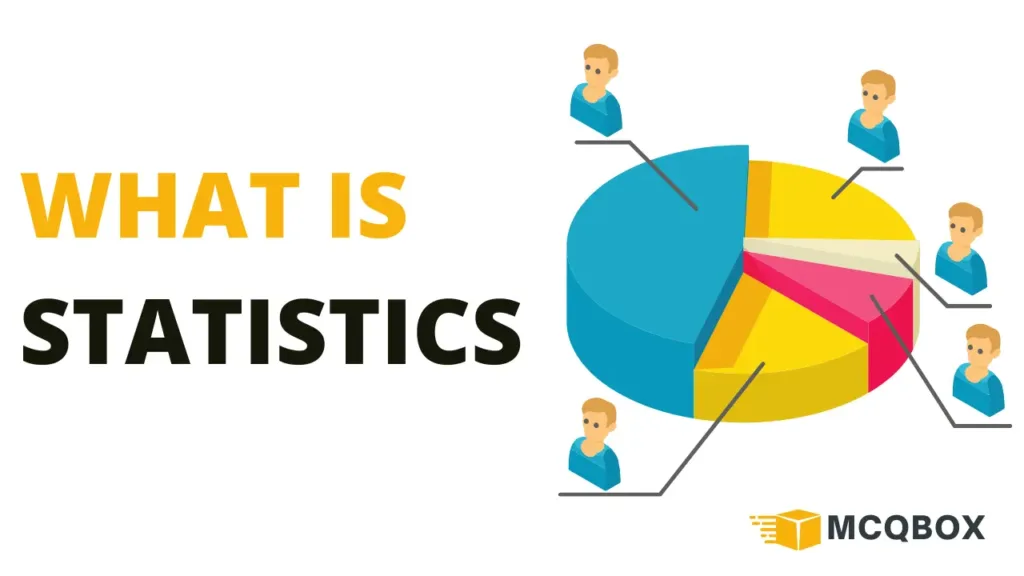Table of Contents
What is Statistics

What is Statistics- Statistics is the science of collecting, analyzing, interpreting, and presenting data. It encompasses a wide range of techniques used to understand patterns and trends within datasets, making it a crucial tool in various fields from academia to industry.
According to Merriam-Webster dictionary, statistics is defined as “classified facts representing the conditions of a people in a state – especially the facts that can be stated in numbers or any other tabular or classified arrangement”.
According to Sir Arthur Lyon Bowley, statistics is defined as “Numerical statements of facts in any department of inquiry placed in relation to each other”.
Importance of Statistical Analysis
Statistical analysis allows us to make informed decisions based on data rather than intuition or guesswork. Whether it’s predicting stock market trends, understanding consumer behavior, or evaluating the effectiveness of medical treatments, statistics provides the framework for extracting meaningful insights from complex information.
EXAMPLE
Imagine you’re an MBA student tasked with analyzing the exam scores of students in a finance course. You have a dataset containing the marks obtained by each student in the class.
Using statistical techniques, you can explore various aspects of the data to understand the performance of the students.
- You might calculate the average mark to determine the overall performance of the class.
- You could also calculate measures of dispersion such as the standard deviation to understand how scores vary around the mean.
- Furthermore, you might create histograms or box plots to visualize the distribution of marks and identify any patterns or outliers.
This can help you understand the spread of scores and identify students who may need additional support.
In this example, statistics enables you to gain insights into the academic performance of students, identify areas for improvement, and make data-driven decisions to support their learning journey.
Types of Statistics
There are two types of Statistics
- Descriptive Statistics
- Inferential Statistics
Descriptive Statistics
Descriptive statistics involves summarizing and describing the characteristics of a dataset. Its primary purpose is to simplify large amounts of data into understandable patterns, making it easier to interpret and communicate findings.
Descriptive statistics simplifies complex datasets by summarizing key features. Measures of central tendency such as the mean, median, and mode provide insights into typical values, while variability measures like standard deviation quantify the dispersion of data points around the mean.
1. Mean, Median, Mode
The mean, or average, represents the central value of a dataset by summing all values and dividing by the total number of observations. The median is the middle value when the data is arranged in ascending order, while the mode is the most frequently occurring value.
2. Variability Measures
Standard deviation measures the average distance of data points from the mean, indicating the spread of values within the dataset. A higher standard deviation suggests greater variability, while a lower standard deviation indicates more consistency.
3. Data Visualization
Data visualization techniques complement descriptive statistics by providing graphical representations of data distribution and trends.
4. Graphical Representation
Graphs such as histograms, bar charts, and line graphs offer visual insights into the distribution of data, making it easier to identify patterns and outliers.
5. Tabular Presentation
Tables summarize data in a structured format, facilitating comparisons and analysis across different categories or variables.
Inferential Statistics
Inferential statistics aims to infer properties of a population based on a sample of data. It extends the findings of descriptive statistics to make predictions, test hypotheses, and draw conclusions about the larger population from which the sample is drawn.
Inferential statistics extends beyond descriptive analysis to make predictions and draw conclusions about populations based on sample data.
1. Hypothesis Testing
Hypothesis testing evaluates the likelihood of observed differences or relationships between variables occurring by chance, helping researchers assess the validity of hypotheses and make informed decisions.
2. Confidence Intervals
Confidence intervals provide a range of values within which a population parameter is likely to lie, offering a measure of uncertainty around sample estimates and enhancing the reliability of statistical findings.
3. Predictive Analysis
Predictive analysis uses inferential statistics to forecast future outcomes and trends based on historical data and existing patterns.
4. Regression Analysis
Regression analysis examines the relationship between one or more independent variables and a dependent variable, enabling predictions and identifying factors that influence outcomes.
5. Correlation Studies
Correlation studies assess the strength and direction of associations between variables, helping researchers identify patterns and make predictions about potential outcomes.
Practical Applications of Statistics
Statistics finds widespread application across various domains, including:
1. Business and Economics: Market research, financial analysis, and forecasting demand.
2. Healthcare and Medicine: Clinical trials, epidemiological studies, and disease surveillance.
3. Social Sciences: Survey research, demographic analysis, and policy evaluation.
Summary
Statistics plays a vital role in understanding and interpreting data, providing valuable insights that drive decision-making across diverse fields. By distinguishing between descriptive and inferential statistics, researchers can effectively analyze datasets, make predictions, and draw meaningful conclusions to inform evidence-based practices and policies.
MCQ on Statistics
FAQs
Descriptive statistics summarize data to describe its characteristics, while inferential statistics make predictions and draw conclusions about populations based on sample data.
Measures like the mean, median, and mode provide insights into typical values within a dataset, helping researchers understand its central tendencies.
Probability theory allows researchers to assess the likelihood of observed patterns occurring by chance, enabling them to make inferences about populations from sample data.
Common graphical representations include histograms, pie charts, scatter plots, and bar charts, which offer visual insights into the distribution and trends within datasets.